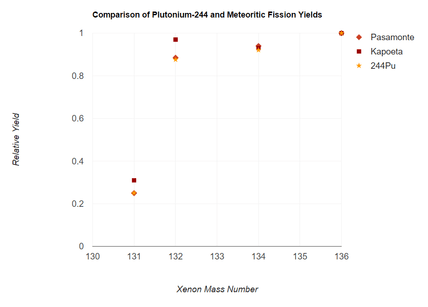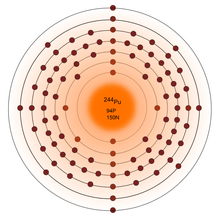Extinct isotopes of superheavy elements
Extinct isotopes of superheavy elements are isotopes of elements whose half-lives were too short to have lasted through the formation of the solar system[1] and, because they are not replenished by natural processes, can nowadays only be found as their daughters trapped within sediment and meteorite samples dating billions of years ago.
Carbonaceous chondrite fission xenon
Carbonaceous chondrite fission Xe, often abbreviated as CCF Xe, are a collection of different isotopes of xenon that were thought to have arisen from the decay of a superheavy element within the island of stability. Early studies proposed that the half life of the theoretical progenitor of CCF Xe to be on the order of 108 years.[2] A later attempt at characterization of the progenitor in 1975 by Edward Anders, a professor of chemistry at the University of Chicago, and colleague John Larimer suggested a heat of vaporization of 54 kJ/mol and a boiling point of 2500K for the element and, based on estimated accretion temperatures, they also proposed elements 111 and 115 (today named roentgenium and moscovium) as the most likely candidates assuming the element condensed in pure form.[3]
Allende meteorite
Anders went on to study samples of the Allende meteorite, the largest carbonaceous chondrite ever found on Earth. Results of these studies suggested element 113-115 (today nihonium, flerovium, and moscovium)[4] as the most likely candidates for the progenitor of CCF Xe. These studies also proposed that the progenitor condensed as an iron chromium sulfide.[5] This is later called into question as iron chromium sulfide is very rare with a relative abundance of 0.4%.[6]
Evidence against carbonaceous fission xenon
By the 1980s, CCF Xe actually being the product of fission was doubtful, and the alternate theory that it had arisen from r-process (neutron capture) nucleosynthesis gained more ground.[7] Researchers looked at the isotopic anomalies in neighboring elements Barium, Neodymium and Samarium isotopes and compared to the amount of Xe. Whether CCF Xe was produced by nucleosynthesis or fission, comparable amounts of barium 135 should be produced.[6] When researchers compared the experimental data to predicted amounts of Barium following each model, neither model even came close to predicting the anomalies correctly, leading to Lewis and co. calling the experiment an "embarrassment" for both models. However, in the case of nucleosynthesis, it is possible that Sm, Nd, and Ba were separated from Xe by prior condensation in the supernova shell or plasma processes.[6] Based on this data it was deemed unlikely that CCF Xe had actually arose from fission.
Plutonium-244

Plutonium-244 is one of several extinct radionuclides that preceded the formation of the solar system. Its half-life of 80 million years ensured its circulation across the solar system before its extinction[1] and indeed, 244Pu has not yet been found in matter other than meteorites.[9] Radionuclides, such as 244Pu, undergo decay to produce fissiogenic - arising from fission - xenon isotopes that can then be used to time the events of the early solar system. In fact, by analyzing data from Earth’s mantle that indicate that about 30% of the existing fissiogenic xenon is attributable to 244Pu decay, the timing of Earth’s formation can be inferred to have occurred nearly 50-70 million years following the formation of the solar system.[10]
Identification and discovery

Preceding the analysis of mass spectra data obtained by analyzing samples found in meteorites, it was inferential at best to accredit 244Pu as being the nuclide responsible for the fissiogenic xenon found. But an analysis of a laboratory sample of 244Pu compared with that of fissiogenic xenon gathered from the meteorites Pasamonte and Kapoeta produced matching spectra that immediately left little doubt as to the source of the isotopic xenon anomalies. Spectra data was further acquired for another actinide, 244Cm, but such data proved contradictory and helped erase further doubts that the fission was appropriately attributed to 244Pu.[11]
Both the examination of spectra data and study of fission tracks led to several findings of Plutonium-244. In Western Australia, the analysis of the mass spectrum of xenon within 4.1 - 4.2 Gy-old zircons was met with findings of diverse levels of 244Pu fission.[1] Presence of 244Pu fission tracks can be established by using the initial ratio of 244Pu to 238U (Pu/U)0 at a time T0 = 4.58×109 years, when Xe formation first began in meteorites, and by considering how the ratio of Pu/U fission tracks varies over time. Examination of a whitlockite crystal within a lunar rock specimen brought over from the Apollo 14 mission established proportions of Pu/U fission tracks consistent with the (Pu/U)0 time dependence.[9]
| Radionuclide | Half-life (years) | Method of Decay | Decay Products |
|---|---|---|---|
| 244Pu | 8.00×107 | α decay, spontaneous fission | 232Th, 131-136Xe |
| 146Sm | 6.80×107 | α decay | 142Nd |
| 129I | 1.57×107 | β- decay | 129Xe |
| 247Cm | 1.56×107 | α decay | 235U |
| 182Hf | 8.90×106 | β- decay | 182W |
| 107Pd | 6.5×106 | β- decay | 107Ag |
| 53Mn | 3.74×106 | electron capture | 53Cr |
| 60Fe | 2.62×106 | β- decay | 60Ni |
| 26Al | 7.17×105 | β+ decay, electron capture | 26Mg |
References
- Turner, Grenville; Harrison, T. Mark; Holland, Greg; Mojzsis, Stephen J.; Gilmour, Jamie (2004-01-01). "Extinct $^{244}Pu$ in Ancient Zircons". Science. 306 (5693): 89–91. Bibcode:2004Sci...306...89T. doi:10.1126/science.1101014. JSTOR 3839259. PMID 15459384.
- Schramm, David N. (1971-09-24). "Implied Superheavy Element Decay Lifetime from Meteorites". Nature. 233 (5317): 258–260. Bibcode:1971Natur.233..258S. doi:10.1038/233258a0. PMID 16063318.
- Anders, Edward; Larimer, John W. (1972-01-01). "Extinct Superheavy Element in Meteorites: Attempted Characterization". Science. 175 (4025): 981–983. Bibcode:1972Sci...175..981A. doi:10.1126/science.175.4025.981. JSTOR 1732722. PMID 17791931.
- Anders, Edward; Lewis, R.S. (1981-03-01). "XE129 and the Origin of CCF Xenon in Meteorites". LUNAR AND PLANETARY SCIENCE XII, P. 616-618. Abstract.: 616. Bibcode:1981LPI....12..616L.
- Anders, Edward; Higuchi, H.; Gros, Jacques; Takahashi, H.; Morgan, John W. (1975-01-01). "Extinct Superheavy Element in the Allende Meteorite". Science. 190 (4221): 1262–1271. Bibcode:1975Sci...190.1262A. doi:10.1126/science.190.4221.1262. JSTOR 1741804.
- Lewis, R. S.; Anders, E.; Shimamura, T.; Lugmair, G. W. (1983-01-01). "Barium Isotopes in Allende Meteorite: Evidence against an Extinct Superheavy Element". Science. 222 (4627): 1013–1015. Bibcode:1983Sci...222.1013L. doi:10.1126/science.222.4627.1013. JSTOR 1691282. PMID 17776244.
- Black, David C. (1975-02-06). "Alternative hypothesis for the origin of CCF xenon". Nature. 253 (5491): 417–419. Bibcode:1975Natur.253..417B. doi:10.1038/253417a0.
- Alexander, E. C.; Lewis, R. S.; Reynolds, J. H.; Michel, M. C. (1971-01-01). "Plutonium-244: Confirmation as an Extinct Radioactivity". Science. 172 (3985): 837–840. Bibcode:1971Sci...172..837A. doi:10.1126/science.172.3985.837. JSTOR 1731927. PMID 17792940.
- Hutcheon, I. D.; Price, P. B. (1972-01-01). "Plutonium-244 Fission Tracks: Evidence in a Lunar Rock 3.95 Billion Years Old". Science. 176 (4037): 909–911. Bibcode:1972Sci...176..909H. doi:10.1126/science.176.4037.909. JSTOR 1733798. PMID 17829301.
- Kunz, Joachim; Staudacher, Thomas; Allègre, Claude J. (1998-01-01). "Plutonium-Fission Xenon Found in Earth's Mantle". Science. 280 (5365): 877–880. Bibcode:1998Sci...280..877K. doi:10.1126/science.280.5365.877. JSTOR 2896480. PMID 9572726.
- Alexander, E. C.; Lewis, R. S.; Reynolds, J. H.; Michel, M. C. (1971-01-01). "Plutonium-244: Confirmation as an Extinct Radioactivity". Science. 172 (3985): 837–840. Bibcode:1971Sci...172..837A. doi:10.1126/science.172.3985.837. JSTOR 1731927. PMID 17792940.